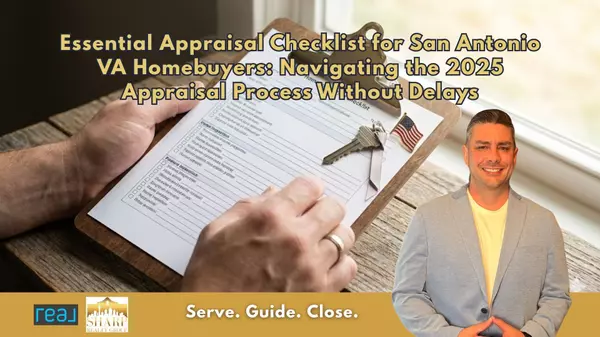Why Every Military Home Seller Needs a CMA for PCS Moves

Why Every Military Home Seller Needs a CMA for PCS Moves
Hi, I’m Anthony Sharp, a U.S. Air Force veteran, San Antonio Realtor®, and Military Relocation Specialist. I’ve worn the uniform and I’ve sold homes during PCS moves, so I know exactly what you’re facing. In this guide, I’ll explain why a Comparative Market Analysis (CMA) is absolutely mission-critical when you need to sell your home during a Permanent Change of Station (PCS).
Every year, more than 400,000 service members receive PCS orders, often with just a few months to pack up and move. If you’re among the 63% of active-duty families living off-base, a PCS likely means one thing: you need to sell your house, and sell it fast. In my own military career and real estate practice, I’ve seen too many fellow service members stress over pricing and timing. The good news? A well-done CMA can be your secret weapon to price your home right and get it sold on schedule, without leaving money on the table.
Let’s start with a free CMA and game plan. Contact me today for your free home analysis!
Get Your Free CMA
In This Article
- What Exactly Is a CMA (Comparative Market Analysis)?
- The PCS Difference: Why Military Home Sales Are Time-Sensitive
- 5 Reasons Every Military Home Seller Needs a CMA Before Listing
- Military Market Insights You Won’t Get from Zillow
- Real-Life Case Study: The Smith Family’s PCS Sale
- Frequently Asked Questions (FAQ)
What Exactly Is a CMA (Comparative Market Analysis)?
A Comparative Market Analysis, or CMA, is a detailed report that evaluates your home’s value based on recent sales and current listings of similar homes in your area. Think of it as the intel briefing for your home’s market value. A proper CMA looks at homes like yours, same neighborhood, similar size, age, and features, that sold recently or are on the market now.
By analyzing these “comps,” a CMA pinpoints a data-backed price range for your home. Unlike a quick online estimate, a professional CMA runs 30-50 pages of data, charts, and photos analyzing every angle. It’s typically prepared by a Realtor for free (no obligation) as part of their service. The goal is to land on a competitive listing price that’s not too high or too low, just right to attract buyers and maximize your profit.
Why is this so vital for military sellers? Because in a PCS situation, pricing your home correctly from Day 1 is non-negotiable. You often don’t have the luxury of “testing” the market with a too-high price. A CMA is how we get the price right the first time, with no guesswork.
The PCS Difference: Why Military Home Sales Are Time-Sensitive
Military moves aren’t like regular moves, they’re on a countdown clock. When Uncle Sam says it’s time to go, you usually have 60-90 days to report to your new duty station. That means, as a home seller, you might have only a few weeks to list, sell, and close on your house.
In fact, under normal conditions a home sale can take 85–90 days from listing to closing, but PCS orders often demand a much faster turnaround.
Why Timing Matters So Much
Timing is critical when selling a military home. If your home doesn’t sell before you move, you could end up paying two housing payments – your old mortgage plus rent or mortgage at the new base. Most military families can’t afford that double hit.
Also, peak PCS season is typically summer. In San Antonio (home to Fort Sam Houston, Lackland AFB, Randolph AFB), that’s already a hot real estate market. Come May–August, there are more buyers out looking, but also more sellers. Your listing needs to stand out and attract offers quickly among a wave of other military homes hitting the market.
On top of that, you may have to handle the sale remotely if you’ve already left for your next station. Paperwork, inspections, and closing might happen while you’re in another state or country. It’s doable (I often arrange power-of-attorney closings for my clients), but it adds complexity. And of course, there’s the emotional strain: uprooting your life, moving kids and family, all on a deadline.
Bottom line: In a PCS move home sale, time is your enemy. Every extra day your house sits unsold is a day closer to paying that next mortgage payment (or worse, paying for two homes). This is why pricing it right from the start is mission-critical. An overpriced home that lingers can absolutely derail your PCS timeline.
5 Reasons Every Military Home Seller Needs a CMA Before Listing
Let’s break down exactly how a CMA helps you win this race against time. Here are five key reasons a CMA is invaluable when selling your home during a PCS move:
1. Accurate Pricing from Day One
A CMA ensures you set the right listing price upfront. This is huge. Price too high, and your home could sit on the market for weeks with little interest. Price too low, and you leave hard-earned equity on the table.
With a CMA’s data, we can price competitively – high enough to maximize your profit, but realistic enough to entice buyers quickly. In today’s market, overpricing is a costly mistake: Zillow research shows that homes on the market for around 2 months ultimately sold for 5% below their list price on average, whereas homes that sold quickly (almost as soon as they listed) went for nearly 99% of their list price. In other words, the longer a home lingers, the more likely you’ll end up taking a price cut. A CMA helps us avoid that trap.
2. Speedy Sale to Match Your PCS Timeline
When you only have a few weeks to sell, you can’t afford to “wait and see.” A CMA is your best strategy for a fast sale. By analyzing recent sales, we know what price point will trigger strong buyer interest immediately.
Homes priced right attract more showings in the crucial first two weeks, often yielding offers faster. My goal with every military seller is to get under contract before you have to pack out. Many of my PCS clients get offers within the first 7-14 days because we nailed the price with a CMA.
Data from our local market backs this up: in the San Antonio area, the average Days on Market in early 2025 was about 52–87 days for typical listings. But our military clients often beat that. By pricing sharply and marketing aggressively, we aim to sell well below the average DOM, so you close by the time you’re due to sign in at your new base. (And if the market is hotter during summer, a good price can even spark multiple offers, letting you choose the best terms.)
3. Avoiding Price Reductions (and Buyer Skepticism)
Did you know over 30% of home listings end up cutting their price before selling? In a rising-inventory market, this is usually because they started out too high. Every price drop not only delays your sale, it can also signal to buyers that “maybe something’s wrong with this house.”
By leveraging a CMA, we set the correct price from the get-go, reducing the chance we’ll need any markdown. This strengthens your negotiating position too. I arm my sellers with the CMA report when offers come in. For example, if a buyer offers low, we can point to recent comps in the CMA to justify why our price is fair.
It’s hard for a buyer to argue with hard data showing that, say, three similar homes sold for $400K–$410K in the last month – it validates our asking price. Knowledge is power in negotiations, and the CMA gives us that edge.
4. Data-Driven Decisions at Every Step
A CMA isn’t just about setting price; it informs your whole selling strategy. The detailed market data helps answer questions like: Should we list now or wait a couple weeks? (For instance, is the market trending up or down this month?)
What fixes or upgrades pay off? (The CMA might show that homes with upgraded kitchens in your area sold for 5% more – a hint that a little TLC could boost your price.) How should we market the home? (If the CMA reveals most buyers in your neighborhood are families, we’ll emphasize the great school district and backyard in marketing.)
Essentially, the CMA gives us a snapshot of the battlefield so we can plan the best approach. It even helps with timing the list date. If comps show homes selling faster at, say, the beginning of PCS season, we’ll aim to hit the market early in summer to catch that wave of incoming buyers. As NAR puts it, a “just right” price is one that attracts a buyer quickly and puts the most money in your pocket – a CMA is how we find that sweet spot.
5. Peace of Mind for You (Minimize Stress)
Perhaps most importantly, having a professional CMA in hand reduces your stress during an already stressful PCS. Instead of guessing your home’s value or relying on hearsay, you’ll have confidence that an expert (who knows both real estate and military moves) has crunched the numbers. It’s one less thing to worry about.
You can make informed decisions – like whether to accept an early offer or hold out – with the facts in front of you. As a veteran Realtor, my job is not just to sell your house, but to be a trusted advisor. The CMA is a transparent way for me to show you the why behind my pricing advice, so you feel comfortable and in control.
Many of my past military clients have told me the CMA briefing made them feel much more at ease. You have a roadmap to follow. And if your orders change or timeline shifts, we can update the CMA on the fly (market conditions can change month to month). In short, a CMA gives you clarity and a plan, which are priceless when everything else in a PCS move feels chaotic.
Military Market Insights You Won’t Get from Zillow
You might wonder, “Can’t I just look at Zillow or an online estimator to price my home?” Here’s the thing: online estimates are one-size-fits-all algorithms. They don’t account for many nuances – especially not the military-specific factors that can affect your sale. As an MRP-certified agent (Military Relocation Professional), I factor in details like:
Local BAH Rates
Military buyers shop with their Basic Allowance for Housing in mind. An experienced military Realtor will know the BAH for your area and rank bands. For example, if an E-5 with dependents has about $1,935/month BAH in San Antonio (as of 2025), that roughly translates to a certain affordable purchase price. Pricing your home just above what a typical incoming family’s BAH can cover might shrink your buyer pool. A CMA coupled with BAH insight helps us align your price with what military families can comfortably pay.
VA Loan Considerations
Over 90% of military home buyers use VA loans when purchasing a home. VA loans are fantastic (zero down payment is common), but they come with VA appraisals and safety standards. If you wildly overprice your home, even if a buyer bites, a VA appraiser may value it lower and the loan won’t cover the difference. Then your sale can fall through at the last minute. By using a CMA to price at fair market value, we increase the likelihood that the home will appraise for the contract price (VA appraisers essentially look at the same sales data we use in the CMA). This is a critical point many competitors overlook: the list price needs to pass the appraisal test.
PCS Season Dynamics
If you’re selling in peak PCS season, you might have more competition. A generic algorithm doesn’t know that June and July bring a flood of military movers. I do – I’ve lived it. Your CMA will be interpreted through the lens of seasonal supply and demand. If the market is a bit softer in winter, for instance, we might price a hair more aggressively or be prepared for longer days on market. If it’s June and there’s a surge of buyers incoming with new orders, we might push the high end of the CMA range because we know demand is about to spike. These tactical adjustments come from experience and real-time MLS data, not from a one-size-fits-all formula.
Neighborhood and Base-Specific Trends
Military installations can have micro-market trends. Maybe homes near Randolph AFB historically sell faster, or perhaps certain school districts near Fort Sam Houston drive up values. A CMA done by a local expert will account for these subtleties. I’ll pull comps from the neighborhoods most relevant to military families, not just any 1-mile radius.
Frequently Asked Questions (FAQ)
What is a CMA and how do I get one?
A CMA is a detailed report that estimates your home’s market value by comparing it to similar properties. It considers recent sold prices, active listings, and even expired listings. You can get a CMA by contacting a real estate professional – most agents (myself included) offer a free CMA.
When should I start the home-selling process for a PCS move?
As early as possible! Ideally, 90 days out from your report date, you should engage a Realtor and get a CMA done.
What if my home doesn’t sell before I have to leave?
We work hard to avoid that. However, if it happens, you can use a Power of Attorney, rent the home, or explore interim solutions like a bridge loan or VA compromise sale.
What is the difference between a CMA and Zillow estimate?
Zestimates can be handy for a ballpark figure, but they often overlook key factors like upgrades or military-specific nuances. A professional CMA is far more reliable as it involves human judgment and real-time market sentiment.
How do BAH rates affect my home’s value?
BAH directly impacts what military families can afford. A CMA helps us align your price with what incoming buyers can comfortably pay, maximizing the pool of potential buyers.
Categories
Recent Posts













